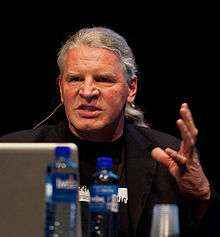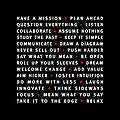Robert L. Peters

Robert L. Peters is a Canadian graphics designer and industrial designer.
Background and Personal Life
Peters was born on May 26, 1954, in Steinbach, Manitoba, Canada to Mennonite missionary parents. His father John Jacob Peters, was born in Russia in 1920 and emigrated as a refugee in 1926, while his mother Amanda Marie Reimer, a direct descendant of Klaas Reimer, was born in Manitoba in 1926. During the Second World War, John Peters served Canada as a voluntary conscientious objector. The family moved to Europe in 1957, where Peters schooled bilingually in Frankfurt and Basel. Following a one-year foundation program in art in Basel, he graduated from Black Forest Academy (Lörrach), and then attended a year of religious studies at Capernwray Hall in the United Kingdom. He subsequently volunteered with Operation Palmbranch, an African relief mission based in Bavaria, Germany.
In 1974 Peters immigrated to Winnipeg, Canada where he earned a two-year Graphic Design diploma from Red River College and a certificate in Design Management from the University of Manitoba. He married Beverly Guay Pauls, a Canadian he had met while studying in England; they divorced in 2001. Since 1982 Peters has lived in an ultra-low-energy, passive solar house that he designed and built on a wooded acreage in Eastern Manitoba.
Professional Activities & Affiliations
In 1976 Peters co-founded the design studio Circle Design Incorporated, which has received more than 60 awards for design excellence and has, in particular, released numerous Canadian postage stamps and first day of issue covers.[1]
From 1984 to 1986, Peters taught Creative Communications at Red River College. Between 1988 and 1993 he taught graphic design at the School of Art, University of Manitoba. Since the early 1990s he has been a guest lecturer on graphic design and visual communication at schools in North America, Asia, and Europe. Between 2004 and 2006, Peters was a guest lecturer at the International Centre for Creativity, Innovation and Sustainability in Hornbaek, Denmark. In 2006, Peters was co-holder of the University of Hartford’s Richard Koopman Distinguished Chair in Visual Arts.[2] During this period Peters's students collaborated with students of Monash University's Russell Kennedy on the "Migrant Immigrant eXchange 2006" (MIX06) project with the aim of encouraging contemporary discourse between Indigenous peoples and non-Indigenous designers/collaborators in Australia and the USA.[3]
Peters served on the executive of the Manitoba Chapter of the Association of Canadian Industrial Designers (ACID/M) before being was elected its president in 1984. He was founding president of the Manitoba branch of the Society of Graphic Designers of Canada (GDC) from 1990 to 1992, and served on the GDC National Council until 1999. From 1994 to 1997 Peters served as a member of The Design Sector Steering Committee, Human Resources Development Canada. In 1998 the GDC named him a Fellow in recognition for his work in professional development and international design advancement. Since 2003 he has served on the GDC’s national Ethics Committee. Following the 1991 International Council of Graphic Design Associations (Icograda) World Design Congress in Montreal, Peters was designated as the GDC’s official delegate and liaison to Icograda at subsequent Icograda General Assemblies between 1992 and 1999. He was appointed to the Icograda board from 1999 to 2005, served as Icograda's President from 2001 to 2003, and also served as official liaison between Icograda and the World Intellectual Property Organization (WIPO) as well as to the United Nations Educational, Scientific and Cultural Organization (UNESCO) from 2001 to 2005. In 2009, Peters received the Icograda President's Award as recognition for his service to the organisation.[4] In 2013, Peters received the Icograda Achievement Award, the highest recognition granted by Icograda to designers for their contribution to the profession.[5]
In 2000, Peters joined the board of the international humanitarian organization Design for the World (DW), and was appointed as a Vice President in 2002. In 2004 he was named an Honorary Member of the Brno Biennale Association; he was a member of the founding executive of the International Design Alliance (IDA) from 2003 to 2005. He serves as a member of the advisory board of the Design Innovation Institute (Dii)[6] and acts as a special ambassador on behalf of the Taiwan Design Center. In 2010, Peters was appointed as an ambassador for INDIGO (the International Indigenous Design Network).[7]
Selected Articles & Publications
Peters has been a regular foreign feature contributor to Communication Arts magazine since 1995, and has written for numerous international design publications including HOW, Print and the AIGA Journal. From 2002 to 2006 Peters served as editor of The Graphic Design Journal, published by the Society of Graphic Designers of Canada. Peters is a member of the editorial advisory group of Geez magazine.[8] In 2009 he began serving on the Applied Arts magazine advisory board regarding design issues.
In 2005, Peters authored the book Worldwide Identity: Inspired Design from Forty Countries (ISBN 1-59253-187-3) published by Rockport in partnership with Icograda, and compiled and designed at Circle; the book showcases over 300 identities from 40 Icograda member countries around the globe. In 2008, Peters edited and published the book Gray Matter Graffiti: remnants of collections lost… an early gallery from some alleyways & other by-ways by Vancouver poet Sam W. Reimer.
Sample Works
 Maxim/Dictum: an in-house manifesto to “work by and live by,” designed at Circle (created in the late 1980s).
Maxim/Dictum: an in-house manifesto to “work by and live by,” designed at Circle (created in the late 1980s). Poster designed in 2005 to promote alternatives to consumerism as espoused by Buy Nothing Christmas.
Poster designed in 2005 to promote alternatives to consumerism as espoused by Buy Nothing Christmas. A poster designed to promote a 2004 presentation on the importance of preparing and using written agreements.
A poster designed to promote a 2004 presentation on the importance of preparing and using written agreements. GDC@50 Poster design, in celebration of the event, GDC Fellows were asked to design a commemorative poster.
GDC@50 Poster design, in celebration of the event, GDC Fellows were asked to design a commemorative poster.
References
- ↑ "Vision Quest" (PDF). Winnipeg Free Press. 13 February 2005. p. D1. Retrieved 24 August 2015.
- ↑ "Hartford Art School" (PDF). University of Hartford. Retrieved 24 August 2015.
- ↑ "Mix06". Mix06. Retrieved 24 August 2015.
- ↑ "Icograda honours Pan Gongkai and Robert L. Peters with the 2009 President's Award". Icograda. Retrieved 24 August 2015.
- ↑ "Achievement Award". Icograda. Retrieved 24 August 2015.
- ↑ "Design Innovation". Design Innovation Institute. Retrieved 24 August 2015.
- ↑ "ICOGRADA INDIGO". Pertubuhan Wakaf Reka Grafik Malaysia.
- ↑ "Geez Staff". Geez Magazine. Retrieved 24 August 2015.
- https://www.gdc.net/excellence/profile/robert-l-peters-fgdc
- www.robertlpeters.com Peters’ personal website
- Circle Design Incorporated Peters’ Winnipeg-based design office